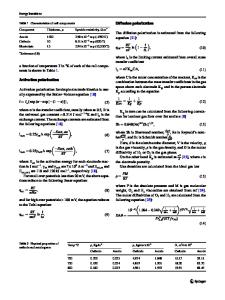Materials and Design Study for Micromachined Solid Oxide Fuel Cells Membranes
- PDF / 1,061,636 Bytes
- 7 Pages / 612 x 792 pts (letter) Page_size
- 85 Downloads / 308 Views
0972-AA07-10-BB08-10
Materials and Design Study for Micromachined Solid Oxide Fuel Cells Membranes Samuel Rey-Mermet and Paul Muralt Ceramics Laboratory, Ecole Polytechnique Fédérale de Lausanne EPFL, STI-IMX-LC, Station 12, Lausanne, 1013, Switzerland
ABSTRACT Miniature solid oxide fuel cells (µSOFCs) are very promising energy sources for portable devices. In this work we report on fabrication and on first experimental results of µSOFCs processed by means of silicon and thin film technology. All the layers involved in the PEN (Positive electrode-Electrolyte-Negative electrode) structure were sputter deposited on silicon wafer. The PEN membrane was liberated using deep silicon dry etching. The cathode is a combination of a very fine platinum grid covered by a thin LSC layer. The electrolyte is a bilayer of YSZ and CGO ionic conductors. Scanning electron microscope and X-ray analysis show that the deposited films are polycrystalline with a columnar microstructure. The conductivities of these films are sufficiently high for cell operation at 550°C. The anode is composed of a NiO-NiCGO composite. A supporting structure consisting of an electroplated nickel grid is deposited on top of the anode and is part of it. The final PEN is a free standing 1 micron thick membrane, with a diameter of 5 mm. First measurements showed that this structure is mechanically stable up to 550°C and that the cell works with an OCV of 200 mV.
INTRODUCTION Today there is a large interest in portable electrical sources beyond Li-ion technology. SOFC in combination with easily available fuel gases such as propane would constitute a viable alternative offering higher power and longer autonomy [1-4]. Most of the ongoing projects are based on porous electrode as substrate for the PEN [5-8]. Theses substrates combine the advantages of having a high triple phase boundary (between the electrolyte, the electrode and the gas) and a very high mechanical stability. However, because of their porosity, it is very difficult to grow dense and thin electrolyte films on these substrates [2, 9] and to avoid particle contamination. With prospects to operate SOFCs at temperatures as low as 500°C [10], and in view of the fact that the electrolyte needs to be thinned down to a few micrometers [11], we decided to explore the possibility to fabricate the complete SOFC structure by means of MEMS and thin film technology. Thereby, it is possible to deposit very thin and dense films directly on the silicon substrate by reactive magnetron sputtering. Furthermore this process has the advantage of being fully compatible with microfabrication methods that are used for the other steps of the µSOFC fabrication route. The most critical issue of such µSOFC cells is the small thickness to diameter ratio of the membrane in combination with compressive thermal stress during operation, leading to buckling and eventually to cracking [12-14]. The usual approach to solve this stability issue is to support the PEN membrane with stiffeners [15]. In this work we decided to support the
Data Loading...











